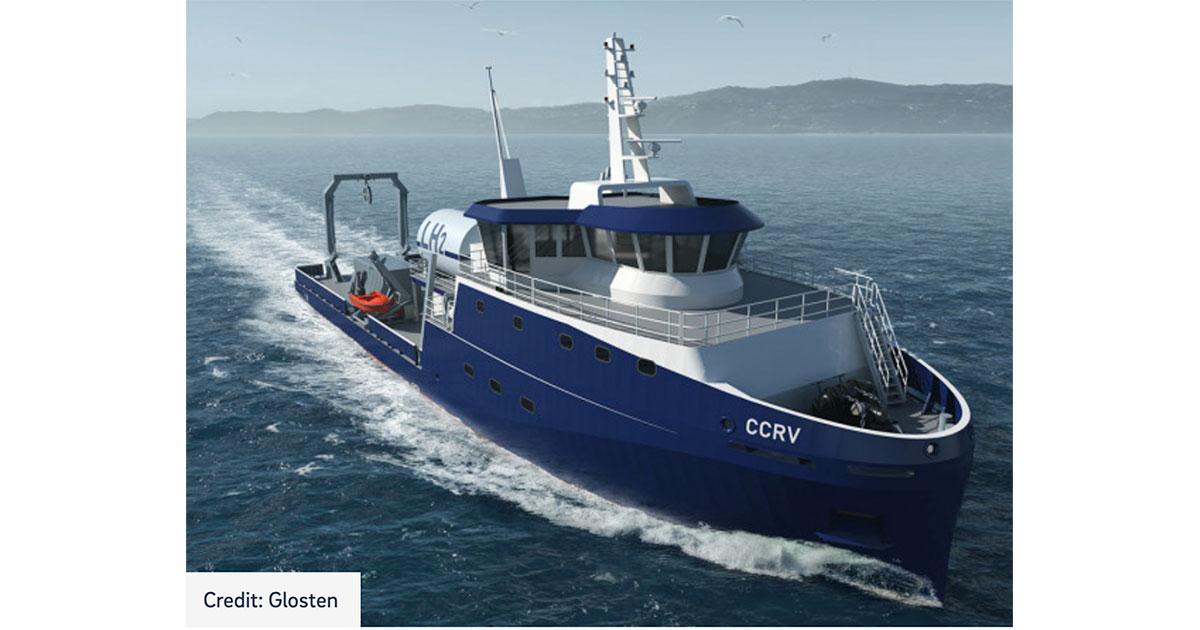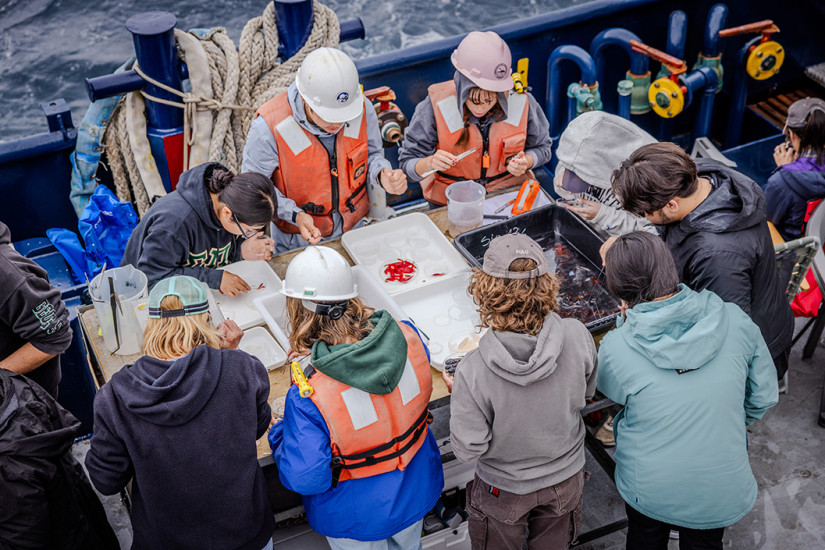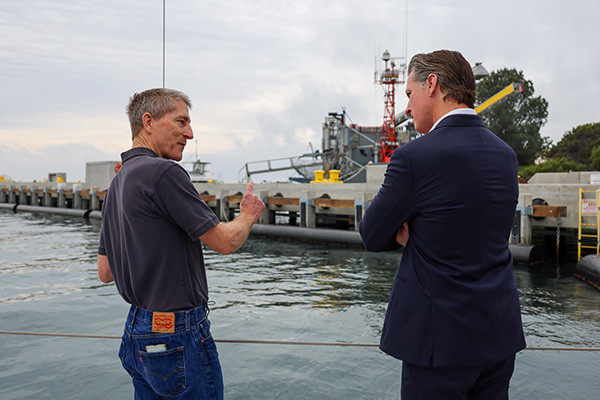Approved Design of the World’s First Hydrogen-Hybrid Research Vessel

The American Bureau of Shipping (ABS) has approved the preliminary design of a first-of-its-kind hydrogen-hybrid research vessel that will join the fleet at UC San Diego’s Scripps Institution of Oceanography when completed.
The vessel’s design was developed by the naval architecture and marine engineering firm Glosten. The preliminary design's approval shows that it meets technical requirements and safety standards and lays the groundwork for the expanded use of zero-emission hydrogen-powered propulsion at sea.
The ship will feature an innovative hydrogen fuel cell propulsion system that will allow it to operate with no greenhouse gas or other emissions for 75% of its missions—and for all of its time operating in state waters. For longer missions farther offshore, extra power will be provided by clean-running modern diesel generators. The zero-emissions-capable vessel represents a major step toward advancing California's pledge to reduce global climate risk while transitioning to a carbon-neutral economy and making progress toward the University of California’s climate action goals.
The ship, now known as the California Coastal Research Vessel (CCRV), will be dedicated to California research missions to observe and measure biological, chemical, geological, and physical processes, including research to better understand fisheries, harmful algal blooms, severe El Niño storms, atmospheric rivers, sea-level rise, ocean acidification, and oxygen depletion zones. The vessel’s findings will help protect California’s coastal environment from climate change impacts while demonstrating hydrogen's critical role in California's carbon-free future.
“Our goal is to produce a fully capable ocean-going research vessel that meets the needs of our scientists and students and demonstrate that this can be done in a way that absolutely minimizes its impact on our environment,” said Bruce Appelgate, Associate Director of Scripps and head of ship operations and marine technical support. “This will be a world-class oceanographic research vessel that aligns with our institutional values for protecting the planet."
The CCRV will also serve as a vital platform for hands-on learning. As a student-centered, research-focused public university, UC San Diego considers seagoing experiences a cornerstone of educational programs. The vessel will be integral to training the next generation of scientists, leaders, and policymakers.

Undergraduate students from SIO 145, Introduction to Field Methods in Biological Oceanography, explore coastal and oceanic ecosystems aboard the Research Vessel Robert Gordon Sproul. The new hydrogen-hybrid vessel will replace R/V Robert Gordon Sproul. (Image credit: UC San Diego’s Scripps Institution of Oceanography)
The new 125-foot vessel will replace Research Vessel Robert Gordon Sproul, which has served thousands of University of California students in its 43 years of service but is nearing completion of its service life. The CCRV will be equipped with the latest instruments and sensing systems, including acoustic Doppler current profilers, seafloor mapping systems, midwater fishery imaging systems, biological and geological sampling systems, and support for airborne drone operations.
As the first liquid hydrogen-powered ship in the United States, the CCRV required the development of an entirely new regulatory framework, setting important precedents for the technical standards governing the construction and operation of hydrogen-powered ships.
“ABS is proud to use our industry-leading insight into hydrogen as a marine fuel to support this project,” said Gareth Burton, ABS Senior Vice President of global engineering. “The CCRV has the potential to make a significant contribution to the wider adoption of hydrogen, a promising alternative fuel for the maritime industry.”
During the vessel’s preliminary design, Glosten worked closely with the American Bureau of Shipping as well as the US Coast Guard to inform regulations and ensure the new liquid hydrogen-powered research vessel complied with them.
“Our challenge was to harmonize the requirements of a modern research vessel with evolving regulations and novel technologies for liquid hydrogen fuel. Ensuring the hydrogen systems were safely arranged without compromising the utility of the vessel was like putting together an intricate puzzle,” said Glosten’s Robin Madsen, the lead marine engineer on the project.

In March 2023, California Governor Gavin Newsom visited Scripps’ Nimitz Marine Facility to learn more about the vessel’s innovation. Here, he is speaking with Bruce Appelgate, associate director of Scripps and head of ship operations and marine technical support. (Image credit: Office of the Governor of California)
In 2021, under Senate President pro Tempore Emeritus Toni Atkins’ leadership, California state legislators allocated $35 million towards the development of the vessel. In March 2023, California Governor Gavin Newsom visited Scripps’ Nimitz Marine Facility to learn more about the vessel’s innovation. Of the CCRV, he said, “California continues to lead the way in clean energy innovation, and this vessel is another step in transitioning to a carbon-neutral economy. It’s great to see UC San Diego and Scripps Oceanography lead the hands-on education, training, and scientific research we need to tackle the climate crisis.”
Additionally, last fall, the Department of Energy (DOE) chose California as one of seven hydrogen hubs, or regions where the agency will fund coordinated networks of hydrogen fuel producers, purveyors, and consumers. A University of California-backed consortium called the Alliance for Renewable Clean Hydrogen Energy Systems, or ARCHES, led the state’s application to DOE and will steer up to $1.2 billion in federal funding toward 39 hydrogen infrastructure projects up and down the state. The CCRV is considered a Tier 1 marquee project for the hub and is eligible to receive additional funding for the project.
In 2018, Glosten, Sandia National Laboratories, and DNV completed a feasibility study funded by the US Department of Transportation Maritime Administration that became the genesis of CCRV. The study evaluated the technical, regulatory, and economic feasibility of the Zero-V concept, a vessel powered by fuel cells and liquid hydrogen designed to meet performance and environmental criteria established by Scripps. The study confirmed that a hydrogen-powered research vessel was possible, and in 2022, the Office of Naval Research supported the preliminary design effort under Award N00014-22-1-2765 (any opinions, findings, and conclusions or recommendations here are those of the authors and do not necessarily reflect the views of the Office of Naval Research).
The team at Glosten is currently progressing the CCRV to the next phase of its design process and will assist Scripps as it begins its search for a contractor to complete the vessel’s construction.

